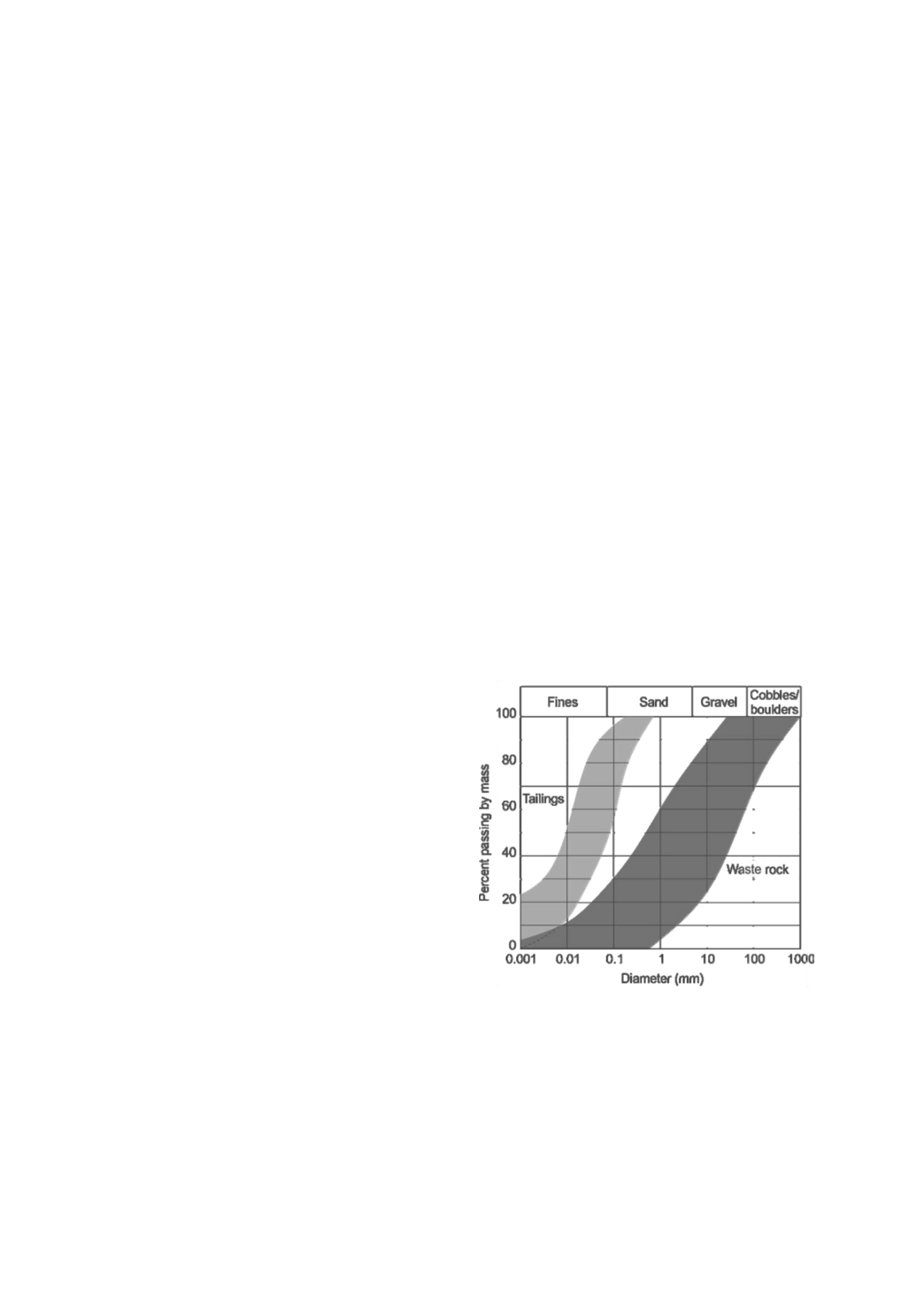
735
On the use of waste rock inclusions to improve the performance of tailings
impoundments
Sur l'utilisation d'inclusions de roches stériles pour améliorer la performance des parcs à résidus
miniers
James M., Aubertin M.
Département des génies civil, géologique et des mines, École Polytechnique, Montréal
Bussière B.
Chaire industrielle CRSNG Poly-UQAT Environnement et gestion des rejets miniers, Université du Québec en Abitibi-
Témiscamingue
ABSTRACT: A novel co-disposal method, consisting of the placement of waste rock in tandem with tailings, improves the
environmental and geotechnical performance of surface impoundments. The waste rock is used to create linear inclusions within the
tailings. These inclusions, being more permeable and more rigid than the tailings, improve the performance in several ways, such as
facilitating consolidation of the tailings and augmenting the physical stability of the impoundment. The benefits of this new concept
are being evaluated by means of in situ and laboratory testing, analytical and numerical methods and monitoring at a tailings
impoundment where it is being implemented.
RÉSUMÉ : Une méthode de co-disposition, qui consiste à placer des roches stériles en tandem avec des résidus miniers, améliore la
performance environnementale et géotechnique des parcs à résidus. Les stériles sont alors utilisés pour créer des inclusions linéaires
dans les résidus. Ces inclusions, plus perméables et plus rigides que les résidus, améliorent la réponse de plusieurs façons, en facilitant
par exemple la consolidation des résidus et en augmentant la stabilité physique du parc. Les avantages de ce nouveau concept,
présenté ici, sont évalués au moyen d’essais in situ et en laboratoire, de méthodes analytiques et numériques, et par le surveillance
d’un parc à résidus où il est mis en œuvre.
KEYWORDS: waste rock, tailings, inclusions, co-disposal, consolidation, stability, liquefaction, seismicity.
1 INTRODUCTION
Mining and mineral extraction produce two primary forms of
solid waste: waste rock excavated to reach ore of economic
value and tailings composed of particles of crushed rock from
the milling process.
Generally, waste rock and tailings are stored on the surface
separately, the waste rock in piles and the tailings in
impoundments. The generation of acid mine drainage (AMD),
the leaching of heavy metals, the presence of contaminants
remaining after ore processing, and the physical stability of the
structures formed by these wastes are critical and costly
considerations during operations and after the closure of mining
facilities.
Aubertin et al. (2002a) proposed a co-deposition method that
creates inclusions of permeable, rigid waste rock in deposits of
relatively impermeable, soft tailings. The use of such inclusions
can result in significant improvement in the environmental and
geotechnical performance of the disposal facitlity. This paper
describes the concept and the expected improvements in the
response of the impoundment based on in situ and laboratory
testing, analytical and numerical studies, and observations at a
site where it is currently in use.
2 MINE WASTES
2.1
Tailings
Tailings are typically produced as slurry composed of rock
particles and process water. The particles range in size from
colloids (less than 0.001 mm) to fine sands (> 0.075 mm) with
the silty fraction dominating. The behavior of tailings is
determined by the grain size distribution, water content and
plasticity. Tailings from hard rocks mines tend to be non-plastic
and are the subject of this research. Typically, the grain size
distribution of such tailings lies within the range shown on
Figure 1.
Figure 1. General range of grain size distributions for tailings and waste
rock from hard rock mines (adapted from Gamache-Rochette 2004 and
Bussière 2007).
For most mines, tailings are deposited hydraulically in
impoundments formed by retention dykes and consolidate under
their own weight. The predominance of fine particles results in
low consolidation rates and porewater pressure build up during
filling. For practical reasons, such as waste water storage and to
prevent acid generation, the water level in tailings
impoundments is often kept near the surface. Such a mass of
loose, saturated, cohesionless material is particularly susceptible
to liquefaction. Numerous failures of tailings impoundments
have been associated with seismically-induced liquefaction,
while impoundment failure from other causes often results in


